[Updated March 26, 2023; Originally published August 2009; video edited and created by Colin Davis. One correction: I no longer have a home in Vermont mentioned in the video, but have not lost my admiration for Robert Frost.]
America’s Poet, Robert Frost, was born on March 26, 1874 –not in New England where so many of his greatest poems are set but in San Francisco.
The first poet invited to speak at a Presidential inaugural, Frost told the new President:
Be more Irish than Harvard. Poetry and power is the formula for another Augustan Age. Don’t be afraid of power.
Apples, birches, hayfields and stone walls; simple features like these make up the landscape of four-time Pulitzer Prize winner Robert Frost’s poetry. Known as a poet of New England, Frost (1874-1963) spent much of his life working and wandering the woods and farmland of Massachusetts, Vermont, and New Hampshire.
As a young man, he dropped out of Dartmouth and then Harvard, then drifted from job to job: teacher, newspaper editor, cobbler. His poetry career took off during a three-year trip to England with his wife Elinor where Ezra Pound aided the young poet. Frost’s language is plain and straightforward, his lines inspired by the laconic speech of his Yankee neighbors.
But while poems like “Stopping by Woods on a Snowy Evening” are accessible enough to make Frost a grammar-school favorite, his poetry is contemplative and sometimes dark—concerned with themes like growing old and facing death. One brilliant example is this poem about a young boy sawing wood, Out, out–
The buzz-saw snarled and rattled in the yard
And made dust and dropped stove-length sticks of wood,
A brief biography of Robert Frost can be found at Poets.org, where there are more samples of his poetry. It includes an account of Frost and JFK.
Frost died on January 29, 1963, in Boston. After his death, an unsigned editorial in the The New York Times, entitled “Ending in Wisdom,” noted:
Robert Frost was more than America’s best-known poet. He was a national figure, almost an institution, a man who went up and down the land saying his poems wherever, it sometimes seemed, two or three Americans were gathered together. He spoke in the language of the common man.
New York Times, January 31, 1963
Robert Frost (Courtesy Library of Congress)
One of my favorite places in Vermont is the Frost grave-site in the cemetery of the First Church in Old Bennington -just down the street from the Bennington Monument, where this video was recorded.
I had a lover’s quarrel with the world
–Robert Frost’s epitaph
(Revised post 1/27/2023; originally published on February 29, 2016)
An appropriate reminder that the Kerner Commission report was issued in February –now marked as Black History Month. But there are too many people who would erase this history.
“Although specific grievances varied from city to city, at least 12 deeply held grievances can be identified and ranked into three levels of relative intensity:
First Level of Intensity
1. Police practices” –The Kerner Report, February 1968
Once again, the United States is confronted by horrifying images of a Black man being pummeled and beaten to death by police officers. These images evoke the familiar sense of disgust, horror and outrage.
But this latest incident is another reminder of a past the country cannot seem to escape. We have been down this road too many times before. And are now coming up to the anniversary of the 1968 Kerner Report that addressed violence in many large urban neighborhoods. The first problem the Commission pointed to was “police practices.”
Remember what President Lyndon B. Johnson said when he announced a formal investigation in rioting in 1967?
–What happened?
–Why did it happen?
–What can be done to prevent it from happening again and again?-President Lyndon B. Johnson in announcing the formation of a commission to investigate urban violence in 1967.
Once again, it is necessary to revisit the Kerner Commission, formed more than fifty years years ago to address violence in American cities.
On July 27, 1967, President Lyndon B. Johnson established an 11-member National Advisory Commission on Civil Disorders. He was responding to a series of violent outbursts in predominantly Black urban neighborhoods in such cities as Detroit and Newark.
On July 29, 1967, President Johnson made remarks about the reasons for the commission:
The civil peace has been shattered in a number of cities. The American people are deeply disturbed. They are baffled and dismayed by the wholesale looting and violence that has occurred both in small towns and in great metropolitan centers.
No society can tolerate massive violence, any more than a body can tolerate massive disease. And we in America shall not tolerate it.
But just saying that does not solve the problem. We need to know the answers, I think, to three basic questions about these riots:
–What happened?
–Why did it happen?
–What can be done to prevent it from happening again and again?Source: Lyndon B. Johnson, Remarks Upon Signing Order Establishing the National Advisory Commission on Civil Disorders. Online by Gerhard Peters and John T. Woolley, The American Presidency Project
On Feb. 29, 1968, President Johnson’s National Advisory Commission on Civil Disorders, later known as the Kerner Commission after its chairman, Governor Otto Kerner, Jr. of Illinois, issued a stark warning:
“Our Nation Is Moving Toward Two Societies, One Black, One White—Separate and Unequal”
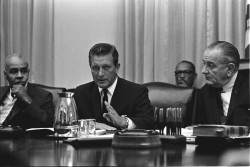
Governor of Illinois Otto Kerner, Jr., meeting with Roy Wilkins (left) and President Lyndon Johnson (right) in the White House. 29 July 1967 Source LBJ Presidential Library
The Committee Report went on to identify a set of “deeply held grievances” that it believed had led to the violence.
Although almost all cities had some sort of formal grievance mechanism for handling citizen complaints, this typically was regarded by Negroes as ineffective and was generally ignored.
Although specific grievances varied from city to city, at least 12 deeply held grievances can be identified and ranked into three levels of relative intensity:
First Level of Intensity
1. Police practices
2. Unemployment and underemployment
3. Inadequate housing
Second Level of Intensity
4. Inadequate education
5. Poor recreation facilities and programs
6. Ineffectiveness of the political structure and grievance mechanisms.
Third Level of Intensity
7. Disrespectful white attitudes
8. Discriminatory administration of justice
9. Inadequacy of federal programs
10. Inadequacy of municipal services
11. Discriminatory consumer and credit practices
12. Inadequate welfare programs
Source: “Our Nation is Moving Toward Two Societies, One Black, One White—Separate and Unequal”: Excerpts from the Kerner Report; American Social History Project / Center for Media and Learning (Graduate Center, CUNY)
and the Roy Rosenzweig Center for History and New Media (George Mason University).
Issued more than half a century ago, the list of grievances reads as if it could have been written today.
“Moreover, the report deplored a common reaction to riots: arming police officers with more deadly weapons to use in heavily populated urban neighborhoods. Its primary recommendation was ‘a policy which combines ghetto enrichment with programs designed to encourage integration of substantial numbers of Negroes into the society outside the ghetto.’” —Smithsonian
[An earlier version of this post appeared in 2013; updated January 30, 2023]
Franklin D. Roosevelt, born January 30, 1882
Photo Courtesy of FDR Library and Museum
“Who was the most influential President?”
That was the question once posed to me by a tenth grader during a Skype session I had with a classroom in rural Pennsylvania.
This is a twist on the “greatest President?” query often asked during these visits. My answer usually involves the four men I graded with an A+ in Don’t Know Much About the American Presidents –Washington, Lincoln and the two Roosevelts.
But my answer focused on Franklin D. Roosevelt, born on this day: January 30, 1882. See “FDR’s Birthday” from the Franklin D. Roosevelt Presidential Library and Museum.
In 1918, Franklin D. Roosevelt survived a bout of influenza during the 1918 Pandemic. How history might have changed had he not.
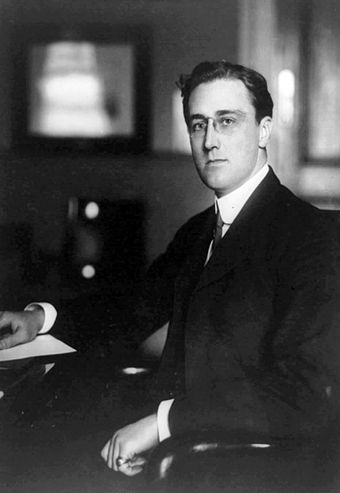
Franklin D. Roosevelt in 1919 as Assistant Secretary of the Navy.
I believe that FDR left the greatest impact on contemporary America. His “New Deal” legacy transformed the country, whether you like it or not. It is a permanent influence best exemplified by a State of the Union address given in January 1941, usually known as the “Four Freedoms” speech.
In it, FDR called for many of the basic elements of the “social safety net” that remains at the heart of political controversy today.
For there is nothing mysterious about the foundations of a healthy and strong democracy. The basic things expected by our people of their political and economic systems are simple. They are:
Equality of opportunity for youth and for others.
Jobs for those who can work.
Security for those who need it.
The ending of special privilege for the few.
The preservation of civil liberties for all.
The enjoyment of the fruits of scientific progress in a wider and constantly rising standard of living.
These are the simple, basic things that must never be lost sight of in the turmoil and unbelievable complexity of our modern world.
In a country still limping out the Great Depression and facing the prospect of the growing war in Europe, FDR also said something else rarely heard from politicians today:
I have called for personal sacrifice. I am assured of the willingness of almost all Americans to respond to that call.
State of the Union (January 6, 1941)
Learn more about FDR and his life and times at The Franklin D. Roosevelt Presidential Library and Museum in Hyde Park, New York, his birthplace.
You can also read more about Franklin D. Roosevelt in Don’t Know Much About History and in Don’t Know Much About the American Presidents.
It is a troubling statistic, but not a surprising one. Just look around. Everybody is on a phone.
It is a problem–and a new pandemic–that has no name. So let’s give it one — Preoccuphonia: The act of being constantly occupied, even addicted, to our smartphones. Maybe that isn’t so smart, after all.
In my new book, Great Short Books, I offer an solution to this obsession— a return to reading. Not as an escape, but as an antidote that helps mind, body, and spirit.
During the pandemic lockdown, with a limited attention span, I read 58 great short books, each approximately 200 pages or less, and by a diverse group of writers. Getting through a little more than one book per week made it “A Year of Reading—Briefly.”
What I rediscovered is that books change lives, hearts, minds, and can fire the imagination. Books convey story and story inspires us. And they can provide, as Joseph Conrad wrote, “that glimpse of truth for which you have forgotten to ask.” Reading improves our physical and psychological well-being—a fact supported by numerous studies, including a Yale study that says reading can add to your longevity.
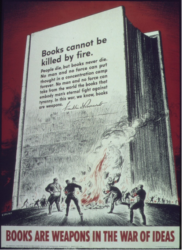
Office of War Information, 1942, Library of Congress, Public Domain
And there is one more key element that must be underscored. Books are essential to preserving democracy. As the censorship battles continue, I believe that “Books are weapons in the War of Ideas,” the slogan of the Armed Services Editions that were provided free to U.S. military personnel during World War II. And I have no doubt: we are in the midst of a war of ideas.
I’d like to share the essential joy and value of reading books with everyone. A couple of suggestions I’d like to humbly offer:
Happy New Year to All
Here are some key organizations leading the fight against book bans and other forms of censorship:
National Coalition Against Censorship
American Library Association (ALA) Office of Intellectual Freedom (OIF)
ACLU (American Civil Liberties Union) “What is Censorship?
I joined veteran newsman Tony Guida on his CUNY TV show “Tony Guida’s New York” to talk about Great Short Books: A Year of Reading–Briefly”
Watch here
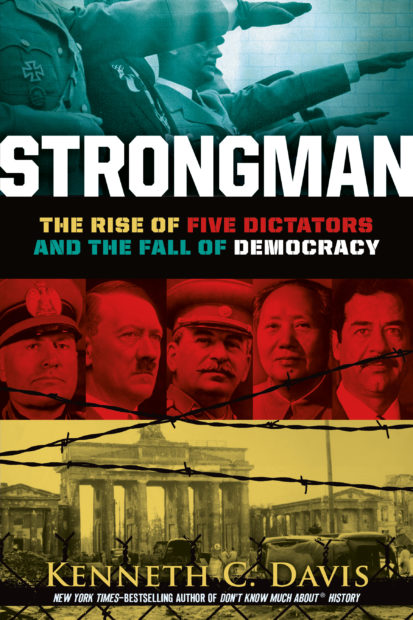
An audiobook is available from Penguin Random House

A review in Booklist says, “Davis does not sugarcoat his material, inviting long thoughts with his assertion that this is a decidedly human story that points to real people as evidence that evil exists in this troubled world.”
In addition to telling how these men took unlimited power, brought one-party rule to their nations, and were responsible for the deaths of millions of people, the book offers a brief history of Democracy and discusses the present threat to democratic institutions around the world.
In a time when Democracy is under assault across the globe, it is more important than ever to understand how a Strongman takes power and how quickly democracy can vanish –even as millions cheer its death.
ADVANCE PRAISE FOR STRONGMAN
“I found myself engrossed in it from beginning to end. I could not help admiring Davis’s ability to explain complex ideas in readable prose that never once discounted the intelligence of young readers. It is very much a book for our time.”
—Sam Wineburg, Margaret Jacks Professor of Education & History, Stanford University, author of Why Learn History (When It’s Already on Your Phone).
“Strongman is a book that is both deeply researched and deeply felt, both an alarming warning and a galvanizing call to action, both daunting and necessary to read and discuss.”
—Cynthia Levinson, author of Fault Lines in the Constitution: The Framers, Their Fights, and the Flaws That Affect Us Today
“A wake-up call to democracies like ours: we are not immune to despots . . . Strongman demonstrates that democracy is not permanent, unless it is collectively upheld. This book shakes that immortality narrative.”
—Jessica Ellison, President of the Minnesota Council for the Social Studies; Teacher Education Specialist, Minnesota Historical Society
“Rarely does a history book take such an unflinching look at our common future, where the very presence of democracy is less than certain; even rarer is a history book in which the author’s moral convictions incite young readers to civic engagement; rarest of all, a history book as urgent, as impassioned, and as timely as Kenneth C. Davis’ Strongman.”
—Eugene Yelchin, author of the Newbery Honor book Breaking Stalin’s Nose
(Video edited and produced by Colin Davis; originally posted October 2011; revised October 2022)
Add me to the list. I think it is well past time that we ditched Columbus Day. Cities and states around the country are changing the name of the holiday to “Indigenous People’s Day” or “Native American Day” to move this holiday away from a man whose treatment of the natives he encountered included barbaric punishments and forced labor.
In writing about Columbus over more than thirty years, three points stand out when I consider this day that marks his arrival:
•the eradication of the native people he encountered and misnamed los indios through forced labor, executions, and the spread of diseases. (Read “Isabella’s Pigs” chapter in America’s Hidden History)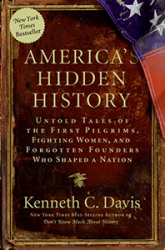
•the introduction of African slavery by the Spanish after the death of so many Native American people who had been forced into slavery by the Spanish demanded a new labor supply
•the carryover of Europe’s religious wars to the Americas (a subject also discussed in America’s Hidden History)
Aside from those big ripples of history, we have to unlearn a basic idea– that Columbus thought the world was round. He didn’t. And wrote as much.
I found it (the world) was not round . . . but pear shaped, round where it has a nipple, for there it is taller, or as if one had a round ball and, on one side, it should be like a woman’s breast, and this nipple part is the highest and closest to Heaven.
–Christopher Columbus, Log of his third voyage (1498)
To me this a lot more interesting than…
“In fourteen hundred and ninety-two/Columbus sailed the ocean blue.”
We all remember that much. But after that basic date, things get a little fuzzy. Here’s what they didn’t tell you–
*Most educated people knew that the world was not flat.
*Columbus never set foot in what would become America.
*Christopher Columbus made four voyages to the so-called New World. And his discoveries opened an astonishing era of exploration and exploitation. But his arrival marked the beginning of the end for tens of millions of Native Americans spread across two continents.
So how did we get a holiday for a man who thought the world was a pear?
In 1892, the 400th anniversary of the arrival of Columbus inspired the composition of the original Pledge of Allegiance and a proclamation by President Benjamin Harrison describing Columbus as “the pioneer of progress and enlightenment.” (Source: Library of Congress, “American Memory: Today in History: October 12”)
That was the patriotic American can-do spirit behind the Columbian Exposition—also known as the Chicago World’s Fair of 1893.
In 1934, the “progress and enlightenment” celebrated in the Columbus narrative was powerful enough to merit a federal holiday on October 12 – a reflection of the growing political clout of the Knights of Columbus, a Roman Catholic fraternal organization that fought discrimination against recently arrived immigrants, many of them Italian and Irish.
Once a hero. Now a villain. Calendars now add “Indigenous People’s Day” or “Native American Day” to shift this holiday away from a man whose treatment of the natives he encountered included barbaric punishments and forced labor.
“Indigenous Peoples’ Day recognizes that Native people are the first inhabitants of the Americas, including the lands that later became the United States of America. And it urges Americans to rethink history.”
Here are more resources on “Indigenous People’s Day” from the Teaching Tolerance organization
The story of “Isabella’s Pigs,” and the role of Queen Isabella in the making of the New World, is depicted in America’s Hidden History

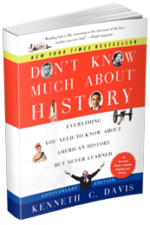
(Originally posted January 26, 2021; revision 10/1/2022)
On October 1, 1946, the verdicts in the first round of Nuremberg (“Nürnberg”) Trials were handed down.
As the Russian invasion and illegal “annexation” of Ukraine continue and the question of war crimes is in the air, it is instructive to look back at the most famous war crimes in history, the Nuremberg Trials of Nazis in the aftermath of the defeat of Nazi Germany. The U.S. delegation was led by Robert H. Jackson
For over a month, during the summer of 1945, representatives of the Soviet, French, U.S. and U.K. governments attempted to reconcile their conflicting legal concepts and devise a workable procedure for the trial. At the core of these intense negotiations was Robert H. Jackson. Jackson refused to back down on certain legal principles, most importantly, the position that aggressive warfare was an international crime.
‘Our view, is that this isn’t merely a case of showing that these Nazi Hitlerite people failed to be gentlemen in war; it is a matter of their having designed an illegal attack on the international peace.’ ”
The Nuremberg Trials — A Don’t Know Much About® Audiominute
On November 20, 1945, in the aftermath of World War II, the first trials of Nazi war criminals began. This military tribunal, the Nuremberg Trials, as they came to be known, was convened by the four victorious Allies—Great Britain, France, the Soviet Union, and the United States.
Listen to this audiominute.
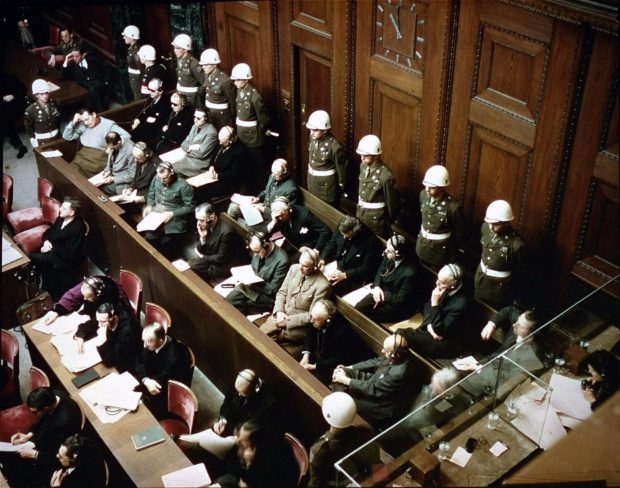
Defendants in the Dock at the Nuremberg Trials (Image: National Archives)
“That four great nations, flushed with victory and stung with injury stay the hand of vengeance and voluntarily submit their captive enemies to the judgment of the law is one of the most significant tributes that Power has ever paid to Reason.
What makes this inquest significant is that these prisoners represent sinister influences that will lurk in the world long after their bodies have returned to dust. We will show them to be living symbols of racial hatreds, of terrorism and violence, and of the arrogance and cruelty of power.”
-United States Prosecutor Robert Jackson, Opening Statement (11/21/1945)
Read Robert Jackson’s full opening statement here
On November 29, 1945, Day 8 of the Nuremberg Trials, a documentary film of the liberated concentration camps taken by American military photographers was shown. (Graphic images).
This is a timeline of the Nuremberg Trials from the Robert H. Jackson Center.
On the morning of Oct. 1, 1946, the Tribunal read the Judgment on the guilt or innocence of the individual defendants. 19 were found guilty on one or more counts of the Indictment. Three were acquitted: Schacht, Fritzche and von Papen.
After lunch on Oct. 1, 1946, Chief Justice Lawrence announced the sentences to the Defendants that were found guilty. Death by hanging: Goering, Ribbentrop, Keitel, Jodl, Kaltenbruner, Streicher, Rosenbeg, Frank, Frick, Sauckel, Bormann and Seyss-Inquart. Life: Hess, Raeder and Funk. Twenty Years: Speer and von Schirach. Fifteen years: von Neurath. Ten Years: Doenitz.
These resources on the Nuremberg Trials are from the Library of Congress.
This is an article about the Nuremberg Trials I wrote in 2005 for the Rutland (VT) Herald.
[Originally posted September 17, 2017]
Answer: On September 17, Washington signed the parchment copy first, as President of the convention.
On September 17, 1787, 39 delegates to the Constitutional Convention meeting in Philadelphia, voted to adopt the United States Constitution.
To recap these events:
Working from May 25, when a quorum was established, until September 17, 1787, when the convention voted to endorse the final form of the Constitution, the delegates gathered in Philadelphia’s Pennsylvania State House were actually obligated only to revise or amend the Articles of Confederation. Under those Articles, however, the government was plagued by weaknesses, such as its inability to raise revenues to pay its foreign debts or maintain an army. From the outset, most the convention’s organizers, James Madison chief among them, knew that splints and bandages wouldn’t do the trick for the broken Articles.
The government was broke –literally and figuratively– and they were going to fix it by inventing an entirely new one. James Madison had been studying more than 200 books on constitutions and republican history sent to him by Thomas Jefferson in preparation for the convention. The moving force behind the convention, Madison came prepared with the outline of a new Constitution.
A reluctant George Washington, whose name was placed at the head of list of Virginia’s delegates without his knowledge, was unquestionably spurred by recent events in Massachusetts (Shay’s Rebellion, a violent protest by Massachusetts farmers). Elected president of the convention, he wrote from Philadelphia in June to his close wartime confidant and ally, the Marquis de Lafayette:
I could not resist the call to a convention of the States which is to determine whether we are to have a government of respectability under which life, liberty, and property will be secured to us, or are to submit to one which may be the result of chance or the moment, springing perhaps from anarchy and Confusion, and dictated perhaps by some aspiring demagogue.
On September 17, Washington signed the parchment copy first, as President of the convention. He was followed by the remaining delegates from the twelve states that sent delegates in geographical order, from north to south, beginning with New Hampshire. (Rhode Island was the only state that did not send a delegation.) When the last of the signatures was added –that of Abraham Baldwin of Georgia– Benjamin Franklin gazed at Washington’s chair, on which was painted a bright yellow sun. He then spoke, as James Madison recorded it:
I have, said he, often in the course of a session, and the vicissitudes of my hopes and fears as to its issue, looked at that behind the President without being able to tell if it was rising or setting: But now at length I have the happiness to know that it is a rising and not a setting sun.
In another perhaps more apocryphal tale, Franklin left the building and was confronted by a lady who asked, “Well Doctor, do we have a monarchy or a republic?” The witty sage of Philadelphia replied,
“A republic, madam, if you can keep it.”
This post is excerpted from America’s Hidden History, which offers fuller account of the Convention and the events that led to it. You can also read more about the Constitutional Convention and the Constitution in Don’t Know Much About History: Anniversary Edition, Don’t Know Much About the American Presidents and In the Shadow of Liberty.
For more about the Constitution, visit these sites:
The National Constitutional Center in Philadelphia and James Madison’s Montpelier
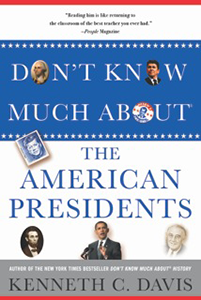
Don’t Know Much About® the American Presidents (Hyperion paperback-April 15, 2014)
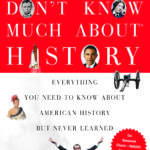
Don’t Know Much About® History: Anniversary Edition

New York Times Bestseller
America’s Hidden History
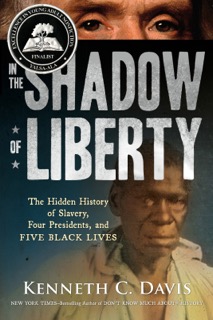
(Revise of 2013 essay)
All I have I would have given gladly not to be standing here today.
Lyndon B. Johnson, in his first address as President to a joint session of Congress (November 27, 1963)
The 36th President, Lyndon B. Johnson, was born on August 27, 1908, in a small farmhouse near Stonewall, Texas on the Pedernales River. Coincidentally, it is also the date on which LBJ accepted the 1964 Democratic nomination for President. (Senator Hubert H. Humphrey was his Vice Presidential nominee.)
In some respects, history and time have been kinder to Lyndon B. Johnson than his tortured Presidency –and certainly the critics of his day—would have possibly suggested. A power broker extraordinaire during his days in Congress, especially during his twelve years in the Senate, Lyndon B. Johnson challenged John F. Kennedy for the Democratic nomination in the 1960 primaries, and then accepted Kennedy’s offer to become his Vice Presidential running mate. Johnson was credited with helping Kennedy win Southern votes and ultimately the election.
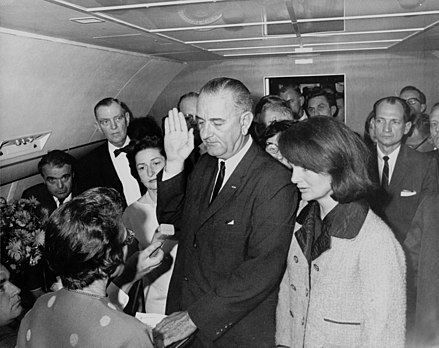
Lyndon B. Johnson taking the oath of office aboard Air Force One at Love Field Airport two hours and eight minutes after the assassination of John F. Kennedy, Dallas, Texas. Jackie Kennedy (right), still in her blood-soaked clothes, looks on. Public Domain-Source White House
On November 22, 1963, history and America changed with Kennedy’s assassination. Johnson became President, taking the oath of office aboard Air Force One with Jacqueline Kennedy, the dead President’s widow standing beside him.
Driven by a rousing sense of social justice, born out of his youth and upbringing in hardscrabble Texas and Depression-era experiences, he had become one of Franklin D. Roosevelt’s most loyal New Dealers. First in a federal job, then in Congress and later as “Master of the Senate.” As President, Johnson set the country on a quest for what he called the “Great Society,” looking for ways to end the great economic injustice and bitter racial disparity that existed in America in 1963. But his vision for a “Great Society” was counterbalanced, and ultimately overshadowed by his doomed course in pursuing the war in Vietnam.
In the midst of the war, recently released White House tapes reveal Johnson confided–
I can’t win and I can’t get out.
Fast Facts-
•Johnson was the first Congressman to enlist for duty after Pearl Harbor.
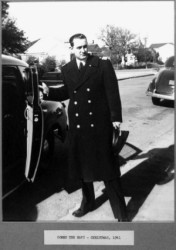
Lyndon B. Johnson as Navy Commander (Photo Credit: Lyndon B. Johnson Library and Museum)
•Johnson was the fourth president to come into office upon the death of a president by assassination. (The others were Andrew Johnson after Lincoln, Chester A. Arthur after Garfield, and Theodore Roosevelt after McKinley.)
•Johnson appointed the first black Supreme Curt Justice, Thurgood Marshall.
The Johnson Library and Museum is in Austin, Texas. Lyndon B. Johnson died at the age of 67 on January 22, 1973.
Resources on Johnson from the Library of Congress
Read more about Lyndon B. Johnson, his presidency and the Vietnam War and civil rights movement in Don’t Know Much About® the American Presidents and Don’t Know Much About® History.
His Vietnam legacy is discussed in the Tet Chapter of The Hidden History of America at War.

The Hidden History of America At War (paperback)
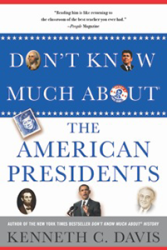
Don’t Know Much About® the American Presidents
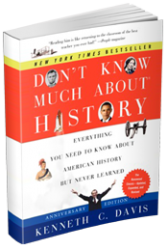
Don’t Know Much About History (Revised, Expanded and Updated Edition)